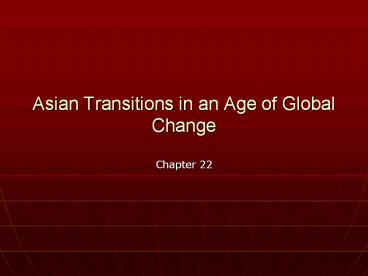Asian Transitions in an Age of Global Change - PowerPoint PPT Presentation
Title:
Asian Transitions in an Age of Global Change
Description:
Asian Transitions in an Age of Global Change Chapter 22 Asian Trading World and the Europeans Vasco da Gama Caravel ships - Asian Sea Trading Network Arab zone ... – PowerPoint PPT presentation
Number of Views:197
Avg rating:3.0/5.0
Title: Asian Transitions in an Age of Global Change
1
Asian Transitions in an Age of Global Change
- Chapter 22
2
Asian Trading World and the Europeans
- Vasco da Gama
- Caravel ships -
- Asian Sea Trading Network
- Arab zone glass, carpets, and tapestry
- India cotton
- China paper, porcelain, and silks
- Red Sea/Persian Gulf
- Straits of Malacca
3
(No Transcript)
4
Calicut
- Asian divisions allowed the success of da Gama
- Ormuz
- Goa
- Malacca
- Factories point where spices and other goods
were stored prior to shipment to Europe
5
Dutch and English Trading Empire
- Dutch and English fleets took advantage of
Portuguese weakness in Asia in order to develop
their own trading empires. - COMMERCE
- Fortified towns
- Factories
- Warships on patrol
- Monopolies of products
- the Dutch even destroyed spices on islands
they did not control and went so far as to remove
or kill people who produced spices without Dutch
control
6
The Dutch Trading Empire
7
The Jesuits Move into Asia
- Francis Xavier
- Robert di Nobili
- Early attempts to convert the untouchables made
the Jesuits off limits to the Indian elite. - Di Nobili adopted Indian culture language,
clothes, and diet in order to attract the Indian
elite but the elite refused to worship with the
lower castes. Did he convert them or they he?
8
Voyages of Francis Xavier
9
MING CHINA
- In 1368 Zhu Yuanzhang came from poverty to take
advantage of the weakness of the Mongol rule in
order to establish himself as the emperor HONGWU
the first of the Ming dynasty. - De-Mongolization
10
Lets Revive the Scholar-Gentry!!! (again)
- Despite his person reservations, Hongwu began the
re-establishment of the civil service examination
system and the rise of the shco9lar gentry. - The examinations became even more important to
the Chinese bureaucracy and would continue to
do so until the end of the Qing dynasty in 1911. - The examination system became even more complex
and bureaucratized. - Hongwu tried to end the corruption that the end
of the Mongol rule was known for and to
increase the power of the emperor - Position of chief minister abolished
- Bureaucrats guilty of corruption or incompetence
were publicly humiliated - Emperors wives were to come from humble families
- The power of the eunuchs were to be limited
- Censorship even of the works of Mencius and the
examinations
11
Ming Prosperity
- Great commercial boom corn, sweet potatoes, and
peanuts. - Massive population growth
- Silk, tea, lacquer-ware for export to the west
- Macao and Canton only places westerners were
officially allowed to do business in China. - Printing, novels, ceramics all became even more
important symbols of Chinese art/culture.
12
The Voyages of Zhenghe
- 1405-1423 admiral Zhenghe led a series of Ming
expeditions throughout Asia and Africa. - Exploration AND promotion
13
(No Transcript)
14
The Ming Begin to Look Inward Mistake?
- 1390 the Ming began to limit Chinese overseas
commerce - The number and size of ships were severely
limited - Yet, Ming emperors were fascinated with the
Jesuits Matteo Ricci and Adam Schall for
example as the Jesuits astonished the Chinese
elite with their science and technology. - While the Franciscans and Dominicans tried to
convert and work among the poor the Jesuits
worked among the elite BUT most of the elite
were wary of the barbarians as the Europeans
were called.
15
The End of the Ming the Dynastic Cycle comes
round a gain
- Retreat from overseas contact was a mistake
- Rampant corruption
- Eunuch control of the Forbidden City
- Infrastructure breakdown
- Floods-droughts-famines
- Peasants turned to banditry
- Pirate attacks
- Chongzhen the last Ming emperor committed
suicide 1644
16
Japan
- Civil wars and power struggles among the daimyo
meant that Japan was ruled by one emperor BUT
that rule and centralization was in name only. - 1573 NOBUNAGA defeated the last Ashikaga
shogun and tried to unite all the daimyo but
was killed in 1582. - Nobunagas general TOYOTOMI HIDEYOSHI continued
the attempt at unification through alliances
and military victories. - By 1590, Hideyoshi was the military commander of
Japan.
17
Japan and the Outside World
- Hideyoshi had dreamed of a Japan that would rule
Korea, China perhaps even India but he died
after failed moves against Korea. - His vassal Tokugawa Ieyasu assumed control and in
1603 was granted the title shogun by the emperor
TOKUGAWA SHOGUNATE - The capital was moved to the city of EDO (now
called Tokyo).
18
- In the early days, Nobunaga used Christianity and
Christian missionaries as tools to counter
balance the power of the Buddhist monks BUT
Hideyoshi and others saw the Europeans
especially the Jesuits as threats to Japanese
power and society. - Hideyoshi ordered the Christian missionaries to
leave Japan but few did at first - 1614 Christianity officially banned
missionaries who did not leave were killed
converts forced to renounce or be imprisoned or
killed. Christianity went underground. - 1616 foreign traders limited to only a select
number of ports - 1630s Japanese forbidden to trade or sail
overseas - 1640s only a small number of Dutch and Chinese
allowed in Nagasaki Bay on the island of
Deshima to trade - Western books banned exportation of gold and
silver limited - Foreigners could only live in select areas
- Even thought looked inward as the School of
National Learning promoted a Japanese centric
approach to all thought and learning.































